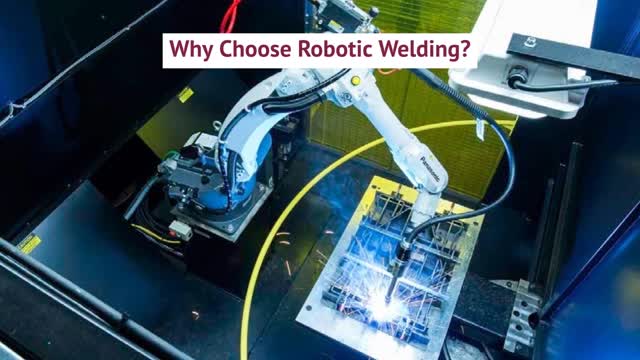Robotic welding is an automated welding process that uses programmable tools—or robots—to handle and weld parts. When paired with the right applications, welding robots allow manufacturers to increase productivity levels and reduce costs while improving weld quality and consistency. This blog explores the applications and advantages of robotic welding and discusses key questions to consider when choosing between robotic and manual welding.
In general, the best candidates for robotic welding are:
- High-throughput, continuous welding operations
- Applications in which weld quality is critical to part performance
- Welding projects involving high-value parts with little-to-no room for error
While the automotive manufacturing sector has long been the primary adopter of robotic welding, technological advancements have expanded the scope of robotic welding to include everything from medical and OEM part manufacturing to furniture construction. Common uses of robotic welding in these industries include:
- Automotive: Industrial welding robots with extended-reach arms and large payload capacities are used to spot-weld automobile body panels and other large structures. Smaller robots are ideal for welding lightweight parts such as mounts or brackets.
- Medical: In the medical industry, welding robots allow critical medical devices and diagnostic equipment to be produced quickly and affordably without sacrificing quality.
- OEM: OEMs rely on robotic welding for the high-volume production of specialized or safety-critical components used in a range of applications.
- Furniture: The furniture building industry uses robotic welding in several applications, from assembling metal chair bases to creating cabinetry framework and room dividers.
Today’s welding robots can be adapted to perform most types of welding, including:
- Resistance welding
- TIG welding
- MIG welding
- Spot welding
- Arc welding
- Plasma welding
- Laser welding
What are the Advantages of Robotic Welding?
Automated welding offers the following benefits:
Improved Weld Quality
Robotic welding improves all aspects of weld quality, including:
- Integrity: Unlike manual welding, robotic welding allows each welding variable (temperature, torch position, etc.) to be tightly controlled. The mechanized torch combined with the precise movement of the parts during the welding process facilitates a higher-quality weld. Robotic welding systems can also be equipped with vision inspection systems, sensors, and leak detection tests to confirm weld quality.
- Repeatability: With more control over the welding variables, welding robots also enable a more repeatable output. The robot can be programmed to position the parts and welding torch within highly specific tolerances, allowing for nearly identical welds across multiple parts.
Increased Output
Robotic welding eliminates human fatigue, distraction, and other issues that can interfere with productivity. Setup time is minimal and weld speeds are controlled by the machine, allowing for much higher output.
Reduced Scrap
By controlling each welding parameter and eliminating human error, robotic welding significantly reduces scrap and weld rework. In some cases, the cost savings from reduced scrap are enough to justify the equipment investment.
Decreased Variable Labor Costs
In manual welding operations, manufacturers must consider the variable costs associated with worker injuries, sick leave, staff overtime, and other factors that affect production. For example, when a welder misses work, the company loses 8-12 hours of production time, causing variable costs to increase.
With robotic welding, labor costs are lower and more predictable. General machine operators are sufficient to handle most robotic welding operations and are typically more affordable and readily available than skilled welders.
When to Choose Robotic Welding Over Manual Welding
In today’s fast-paced manufacturing environment, automated welding processes are often critical to a company’s ability to remain competitive. Robotic welding can provide large productivity gains, but knowing when and where to implement automation in your welding operation is essential for maximizing these benefits.
Key questions to keep in mind when weighing your welding options include:
- What level of automation will be most beneficial to the overall operation?
- What percentage of the budget can be allocated to the welding portion of the operation?
- What are the strengths and weaknesses of the current welding process?
- Is a high-quality weld essential to the part’s performance or safety in its application? What are the consequences of the customer receiving or implementing a faulty part?
- What types of materials are being welded? Are they compatible with automation?
Robotic Welding Services at Rockford Specialties
When used in high-volume or quality-critical welding operations, robotic welding can significantly enhance productivity and weld quality while keeping labor costs low. At Rockford Specialties, we use our extensive industry experience and comprehensive robotic welding services to help clients optimize their welding operations in a range of industries. Our robotic welding capabilities include:
- MIG welding
- TIG welding
- Resistance + spot welding
To learn more about our robotic welding services and general welding capabilities, visit our welding service page or contact us today.

